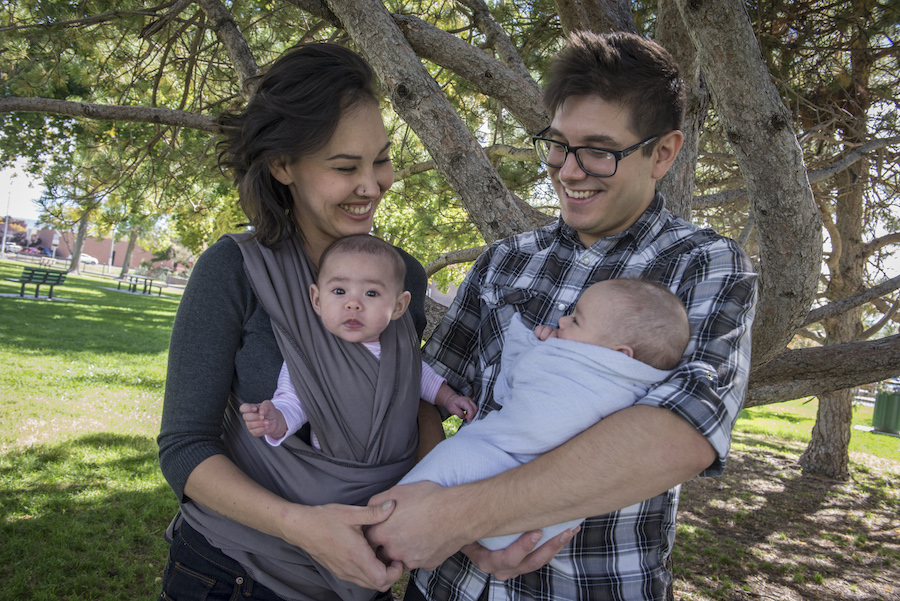
Updated December 23, 2021
Bouncing, Babbling, Bilingual, Babies
Your baby’s first words are a big moment. Whether they start with “Mama” or “Dada” first, or have strong opinions about a new food, babies develop language skills very quickly and are always learning new words.
But what about families who speak more than one language? Is this confusing to your baby? Experts say “no.” In fact, speaking multiple languages has lots of benefits for your little one.
We interviewed Dr. Carol Westby of Bilingual Multicultural Services Inc., to get the facts and some tips for multilingual families to help you give your baby or toddler the best start.
First, the Proven Benefits:
Experts have found that being bilingual improves social skills and empathy, and can build attention and memory. And later, it can even give your little one an edge in getting a job!
There are deeper benefits, too. Besides the practical benefits of being bilingual, learning and keeping home languages is good for children’s wellbeing.
That’s according to Dr. Westby, who said, “Having that first language, maintaining it as you’re learning the other language, that’s part of your identity, and there’s so much work now that shows that mental health in teenagers is very much tied to having a sense of identity.”
Wellbeing? Empathy? A bright future? That all sounds pretty great. So, how can families support their baby or toddler to learn their home language, while also getting a strong start in English?
Make a Plan
Just winging it works for a lot of things (“Let’s just have cereal for dinner!”) but not for building language skills. To have the most success, at least 40% of the words children hear should be in each language you want them to learn. So, in a home where English and Spanish are both spoken, that means 40% English, 40% Spanish, and 20% wiggle room. If a child goes to a child care where English is the primary language, they may get most of their English there, and mainly hear their family language at home.
Use Different Languages in Different Settings
Of course, you aren’t going to calculate the percentages of the words you speak. Dr. Westby said one good approach is to use different languages in different contexts: Maybe when you are cooking or eating together, you might always use your home language. This can also deepen that sense of identity, especially if your home language has specialized words for certain recipes or cultural traditions. Other parts of the routine, like bath time, you might plan to do in English.
One thing to try not to do, according to Dr. Westby, is switching languages within the same conversation. Although babies’ brains are remarkably skilled at sorting out multiple languages, it helps their early development to have some consistency within a conversation.
“While you’re on a topic, keep in the language,” she said. “So if you’re playing, don’t keep switching back and forth.” She added that families should try not to translate for children because some kids will just start waiting for the translation.
Share Family Stories in Your Home Language
Telling family stories in your home languages is another great way to go. After all, hearing a family story is more meaningful for kids than being told (again, for real this time) to put their shoes on. Dr. Westby said using the home language for stories creates different brain connections for kids than if it were just used to give instructions. It also contributes to that strong sense of identity we know is so important to their wellbeing later on.
Keep an Eye on Milestones
Experts know a lot about when babies and toddlers usually develop speech, and when families should look for key milestones. For babies learning more than one language, those speech milestones are similar in many ways, according to Dr. Westby. Children typically can say two or more words (other than “Mama” or “Dada”) by about 12-15 months. By 18-24 months, children typically can combine words into phrases like “Me want cookie.” Those milestones are about the same in children learning multiple languages. What is different, though, is the number of words children know in both languages. A child building their vocabulary in two languages will typically know as many words as their peers who are learning just one language, but those words are spread across two languages. So, if a child learning just English knows about 100 words in English, a bilingual child at the same age might know 50 words in each language. Families should keep this in mind when watching their child’s speech development. If you have concerns about your child’s developing speech, New Mexico offers free, in-home services to help you assess any delays and get your child the supports they need.
Talk a Lot!
Whatever language you’re using, you can support your child’s development through talking, singing, reading, and other ways of sharing stories and speech. Sharing language with your child is a great way to build memories together, build their brains, and build their sense of all the things that make them who they are!

Did you find this article helpful?
Subscribe to Bright By Text to get more free tips and resources for your child’s journey, right to your phone!
